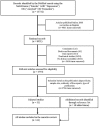A Complex Relationship Between Suicide, Dementia, and Amyloid: A Narrative Review
- PMID: 29910709
- PMCID: PMC5992441
- DOI: 10.3389/fnins.2018.00371
A Complex Relationship Between Suicide, Dementia, and Amyloid: A Narrative Review
Abstract
Background: Suicide rates are high among older adults and many conditions have been related to suicide in this population: chronic illnesses, physical disabilities, cancer, social isolation, mental disorders and neurocognitive disorders. Objectives: Among neurocognitive disorders, analysis of the relationships between dementia and suicidal behaviors led to conflicting results and some questions are still without answer. Particularly, it is not known whether (i) Alzheimer's disease (AD) increases the risk of suicidal ideation and suicide attempts (SA) or the frequency of death by suicide; (ii) the presence of suicidal ideation or SA in people older than 65 years of age is an early dementia sign; and (iii) amyloid load in frontal areas facilitates SA by modifying the decision-making pathway. Methods: Therefore, in this narrative review, we searched the PubMed database using the medical subject heading (MeSH) terms ("Suicide" AND "Depression") OR ("Amyloid" OR "Dementia") to identify recent (from 2000 to 2017) original studies on the links between suicidal behavior, dementia and brain amyloid load. We also explored the clinical and pathophysiological role of depression in these relationships. Results and Discussion: The findings from these studies suggest that late stage dementia could protect against suicidal ideation and SA. Conversely, the risk of complete suicide is increased during the early phase of cognitive decline. Conclusions: Serious cognitive impairment and decline of executive functions could protect against negative thoughts related to cognitive disability awareness and against suicide planning.Several factors, including brain amyloid load, could be involved in the increased suicide rate early after the diagnosis of dementia.
Keywords: Alzheimer's dementia; amyloid; decision-making; depression; suicide.
Figures


References
-
- Barnes D. E., Yaffe K., Byers A. L., McCormick M., Schaefer C., Whitmer R. A. (2012). Midlife vs. late-life depressive symptoms and risk of dementia: differential effects for Alzheimer disease and vascular dementia. Arch. Gen. Psychiatry 69, 493–498. 10.1001/archgenpsychiatry.2011.1481 - DOI - PMC - PubMed
LinkOut - more resources
Full Text Sources
Other Literature Sources

